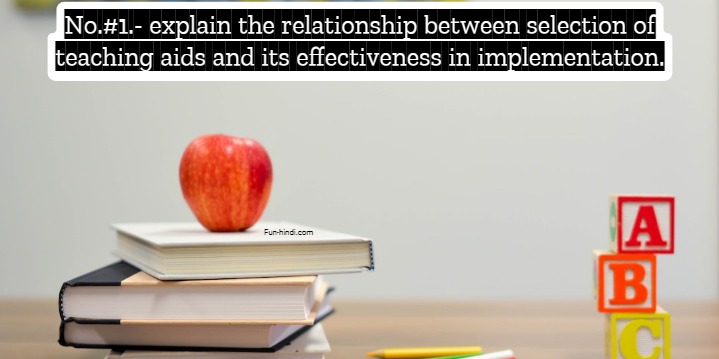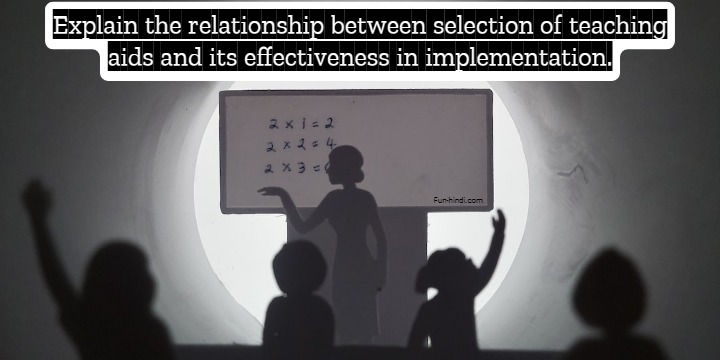Today’s this post about explain the relationship between selection of teaching aids and its effectiveness in implementation. No.#1. to No.#3. ✅✅✅
No.#1.- explain the relationship between selection of teaching aids and its effectiveness in implementation.

The selection of teaching aids plays a crucial role in the effectiveness of their implementation in the classroom. Teaching aids are tools and materials that teachers use to support their teaching and facilitate student learning.
They can include visual aids, multimedia, manipulatives, and other resources that help teachers communicate information and engage students in learning.
When selecting teaching aids, teachers need to consider several factors to ensure their effectiveness in the classroom.
These factors include the learning objectives, the needs and learning styles of their students, the subject matter being taught, the age and level of the students, and the available resources and technology.
If teachers choose teaching aids that are relevant and appropriate for their students’ needs and learning styles, they can enhance student engagement and understanding of the material.
For example, visual aids such as diagrams, charts, and videos can help visual learners grasp concepts more easily, while manipulatives and hands-on activities can help kinesthetic learners understand abstract ideas.
Moreover, the effective implementation of teaching aids involves proper planning and preparation, clear instructions, and active student involvement.
Teachers should use the teaching aids strategically and integrate them into their lesson plans to achieve the desired learning outcomes.
They should also provide opportunities for students to interact with the teaching aids and give them feedback on their performance.
summary
In summary, the selection of teaching aids and their effectiveness in implementation are closely related. The appropriate selection of teaching aids can enhance student learning, but their effectiveness also depends on how well they are integrated into the classroom and how they are used to achieve specific learning goals.
No.#2.- explain the relationship between selection of teaching aids and its effectiveness in implementation.

Another important factor to consider when selecting teaching aids is their accessibility and availability. Teachers need to ensure that the selected teaching aids are accessible and available to all students in the classroom.
For example, if a teacher chooses a multimedia resource, they need to ensure that all students have access to the technology required to use it.
The effectiveness of teaching aids also depends on the teacher’s skills and ability to use them effectively. Teachers need to be trained and competent in using teaching aids to enhance their teaching and students’ learning.
| ✅ Read Also: Best 21 questions for a new relationship with answer |
They should also be able to adapt and modify teaching aids to suit the needs of their students and their lesson objectives.
Another aspect to consider is the cost-effectiveness of teaching aids. Teachers should choose teaching aids that are cost-effective and fit within their budget.
They should also be able to evaluate the effectiveness of the teaching aids and make informed decisions about whether to continue using them or not.
Lastly, it’s essential to note that teaching aids should be used in moderation and not solely relied upon. Teachers should strike a balance between using teaching aids and traditional teaching methods.
Over-reliance on teaching aids may lead to overstimulation or distract students from the learning objectives.
conclusion
In conclusion, the relationship between the selection of teaching aids and their effectiveness in implementation is critical to the success of teaching and learning in the classroom.
Teachers should carefully select teaching aids that meet their students’ needs and their learning objectives, use them strategically and appropriately, and evaluate their effectiveness regularly.
No.#3.- explain the relationship between selection of teaching aids and its effectiveness in implementation.

Another important aspect to consider when selecting teaching aids is cultural relevance. Teachers should choose teaching aids that reflect the cultural backgrounds of their students to enhance their learning experiences.
For example, if a teacher is teaching a history lesson about a particular culture, they should consider using visual aids or artifacts from that culture to help students connect with the material and deepen their understanding.
Furthermore, teachers should also consider the appropriateness of teaching aids for different age groups. For younger students, teaching aids such as puppets, songs, and games may be more effective in engaging their attention and fostering their learning.
In contrast, for older students, technology-based teaching aids such as virtual reality simulations or interactive whiteboards may be more effective.
| ✅ Read Also: “Biography of sachin tendulkar in English” |
Lastly, it’s important to note that teaching aids can be used to support different learning styles, including auditory, visual, and kinesthetic.
Teachers should choose teaching aids that cater to these learning styles to help students understand and retain information more effectively.
For instance, students who prefer auditory learning can benefit from podcasts, while visual learners may find diagrams or mind maps more helpful.
summary
In summary, when selecting teaching aids, teachers should consider cultural relevance, appropriateness for different age groups, and catering to different learning styles.
By doing so, they can enhance the effectiveness of their teaching aids and promote meaningful learning experiences for their students.
FAQs: explain the relationship between selection of teaching aids and its effectiveness in implementation.
What are teaching aids?
Teaching aids are tools and materials that teachers use to support their teaching and facilitate student learning.
They can include visual aids, multimedia, manipulatives, and other resources that help teachers communicate information and engage students in learning.
Why is the selection of teaching aids important?
The selection of teaching aids is important because it can impact their effectiveness in the classroom.
Teachers need to consider several factors when selecting teaching aids, including the learning objectives, the needs and learning styles of their students, the subject matter being taught, the age and level of the students, and the available resources and technology.
How does the selection of teaching aids impact their effectiveness in implementation?
The appropriate selection of teaching aids can enhance student learning, but their effectiveness also depends on how well they are integrated into the classroom and how they are used to achieve specific learning goals.
Effective implementation involves proper planning and preparation, clear instructions, and active student involvement. Teachers should use the teaching aids strategically and integrate them into their lesson plans to achieve the desired learning outcomes.
What are some factors to consider when selecting teaching aids?
When selecting teaching aids, teachers should consider cultural relevance, appropriateness for different age groups, catering to different learning styles, accessibility and availability, cost-effectiveness, and their own skills and ability to use them effectively.
How can teaching aids be used to support different learning styles?
Teaching aids can be used to support different learning styles, including auditory, visual, and kinesthetic. Teachers should choose teaching aids that cater to these learning styles to help students understand and retain information more effectively.
For example, students who prefer auditory learning can benefit from podcasts, while visual learners may find diagrams or mind maps more helpful.

